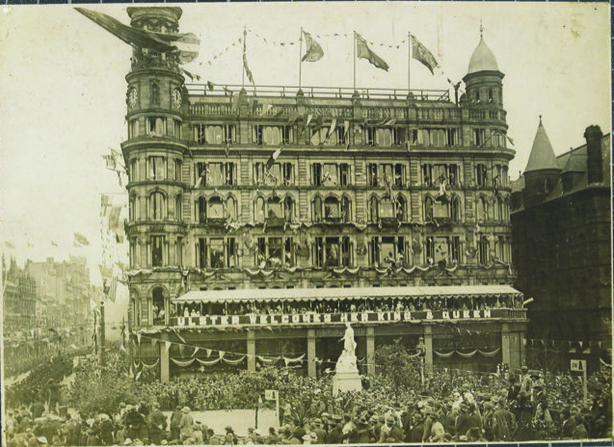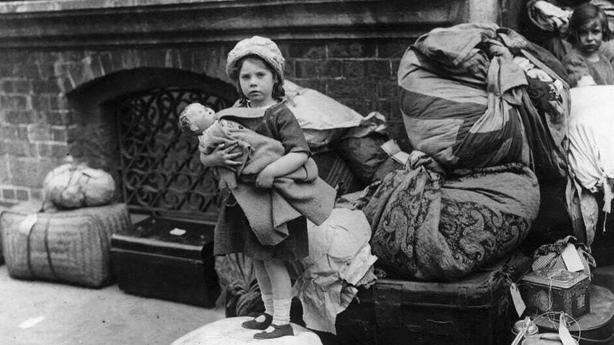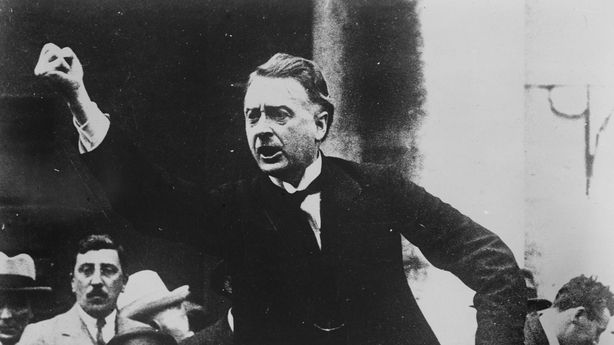Revolutionary Times is a lavishly illustrated coffee-table book chronicling the Irish revolutionary period, based on the hugely popular RTÉ online project, Century Ireland.
This edited extract from Revolutionary Times looks at partition and the creation of Northern Ireland.
The Boundary Commission met for the first time in November 1924, 100 years ago. Set up to determine the boundary between the Irish Free State and Northern Ireland, its final report of the Commission, completed in November 1925, was never published. Disagreements about its recommendations led to the resignation of the Irish Commissioner. As a result, no alterations were made to the border.
In Belfast on June 21st, 1921, there was a great deal of pomp to announce a parliament that nobody had wanted. Having agitated and armed against the idea of a devolved Irish parliament, the unionists of the north-east of the island were now rejoicing at its arrival with a demonstration of loyalty to the Crown that had 'never been surpassed in any part of the Empire'.
Belfast, parts of it anyway, were en fête for the occasion, festooned with Union Jack bunting to greet the arrival of King George V, who sailed in and out on the same day, stopping long enough to deliver a speech at City Hall that urged peace and conciliation among the people of Ireland, while confidently anticipating that the new northern parliament would function with ‘fairness and due regard to every faith and interest, and with no abatement of that patriotic devotion to the Empire which you proved so gallantly in the Great War’. Yet the speed with which the Royal party entered and exited Belfast, and the heavy security arrangements around it, spoke less to the optimism of the monarch’s remarks than to prevailing northern divisions.

The source of this discord lay deep in a history of colonial conquest and settlement, and it found fresh expression in the violence that would serve as both a prelude and postscript to the creation of Northern Ireland.
Take, for instance, some of the violence experienced throughout the first half of 1922 alone. It was shocking in its detail. On 24 March 1922, for example, the family home of Owen McMahon, one of Belfast’s most prosperous Catholic businessmen, was attacked, with McMahon and his 4 sons all murdered, along with a barman who was present in the house at the time. A ‘slaughter house’ was how this newspaper described the scene: large pools of blood were discovered ‘rubbed and disturbed’ in places ‘as if someone had macerated fresh bullocks’ liver and strewn it about’. There was an outraged reaction to the McMahon murders, in which policemen were implicated, as there was in the wake of the harrowing murders the following June of 6 Protestants at Altnaveigh, near Newry. Here, several farmhouses were bombed and burned by members of the IRA’s 4th Northern Division, who had crossed the new border from Co. Louth to a district that was, one IRA Volunteer later asserted, ‘reputed to have connections with a lot of local shootings of Republicans’.

The spiralling violence of 1922 underscored how little impact the truce in the Anglo-Irish war of July 1921 had on a northern experience that saw no pause in bloodletting. Between July 1920 and mid-1922, 500 people were killed across the 6 counties, most in Belfast and mostly civilians. But it was the minority Catholic community who bore the brunt of this violence, and its position within the new Northern Ireland progressively worsened as unionism moved to consolidate its control. Even before local powers (well short of those of a fully-fledged state) had been devolved to Belfast, the character of what was to come was encapsulated in the establishment as an authorised force – in late 1920 – of a Protestant Ulster Special Constabulary (USC) from the ranks of the UVF, which would subsequently stand accused by Nationalist MP, Joseph Devlin, of being ‘worse than the Black and Tans’ for its sectarian callousness. The USC would evolve into the ‘B’ Specials and be retained as a reserve force for the Royal Ulster Constabulary (RUC), which was founded in April 1922 as a replacement for the RIC. Significantly, changes to policing were accompanied by a bolstering of their emergency powers, with the controversial Civil Authority (Special Powers) Act (1922) equipping Northern Ireland’s Minister for Home Affairs to ‘take all such steps and issue all such orders as may be necessary for preserving the peace and maintaining order’. The associated powers were extensive – and extensively used – and they permitted internment without trial and floggings for individuals caught in possession of firearms.
Politically, too, there was a copper-fastening of unionist power as local council constituency boundaries were redrawn, as the swearing of an oath of allegiance was insisted upon, and as proportional representation for local elections (extended later to Westminster elections) was abolished in favour of a first-past-the-post electoral system that worked to disadvantage nationalism and entrench sectarian divisions.

On everything from political participation to educational planning, nationalism chose disengagement. If, perhaps inevitably, such a course exposed nationalists to accusations that their misfortunes were, in part, self-inflicted, subsequent experience did little to suggest that the pursuit of an alternative approach might have resulted in any alleviation of Catholic woes. For the Catholic nationalist population of the 6 counties, hopes that partition would be short-lived proved dismally unfounded: the onset of civil war in the South (and the killing of leaders like Michael Collins) deflected political focus towards the safeguarding of the new Free State, which, under the leadership of W.T. Cosgrave, would adopt a policy of peaceful, if cool, coexistence with the North. Nor did the Boundary Commission fulfil the promise that nationalists had originally invested in it: collapsing in 1925, it left the boundary established by the Government of Ireland Act of 1920 intact, severing many border territories from their natural hinterlands and estranging certain political and religious communities from more obviously sympathetic administrations North and South.
The political arrangements established for Northern Ireland between 1920 and 1922 would not, however, see out the century. Instead, they lasted for only 50 years, when unionism’s refusal to reform led, amidst spiralling violence, to the imposition of direct rule from London in 1973. Devolved government based on genuine power-sharing would have to wait until the signing of the Belfast/Good Friday Agreement in 1998, which, like the Treaty of 1921, again opened up the prospect of future changes to the border and a change to the constitutional status of the 6 counties, conversations around which were given fresh impetus by the UK’s vote to leave the European Union in 2016.
Revolutionary Times is published by the Irish Adademic Press

